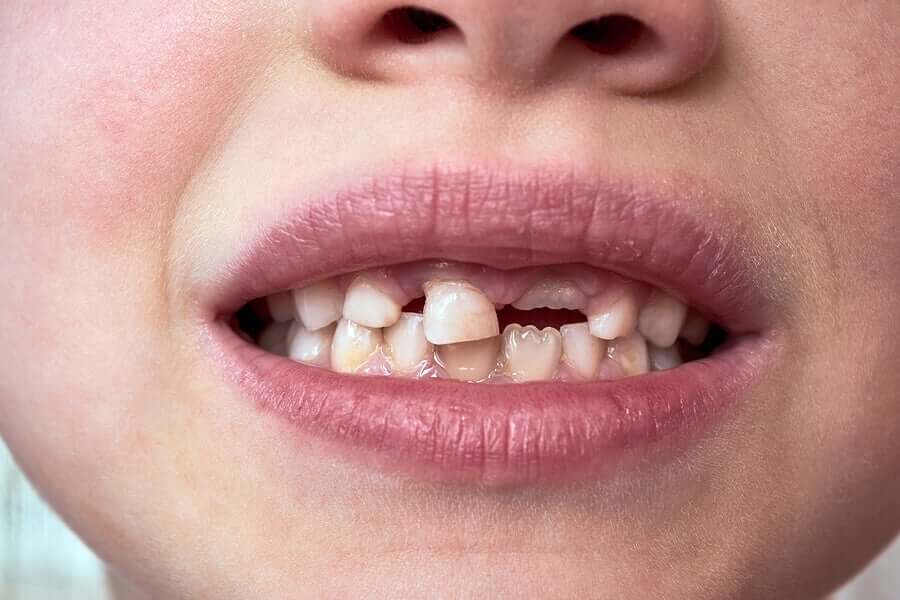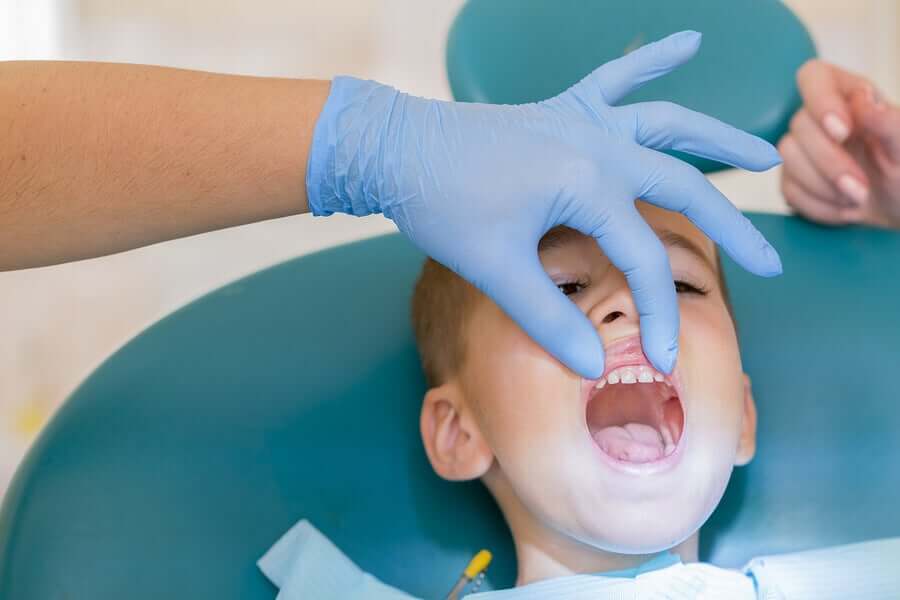Repositioning a Baby Tooth

Repositioning a baby tooth is a treatment by which a dentist grafts a tooth that has been extracted or knocked out, for example due to a blow, back into the gum socket. The aim is for that tooth to re-create ligament fibers with the gum and for it to be able to hold it in place again.
As a general rule, in temporary teeth, also called baby teeth, repositionings are performed as a treatment for avulsions. A dental avulsion is the complete removal of a tooth from its socket, usually by a blow. Often, the teeth most affected teeth are the upper central incisors.
In children, the best possible treatment is to put the tooth back in place to try to re-form tissue. What does this treatment consist of? What are the consequences? Keep reading to learn more.
What happens to the tooth after the avulsion?
When the tooth comes out of the gum completely, the ligament fibers that hold it to the gum break. It also breaks the vasculonervical package that allows the blood supply and nerve currents to reach the tooth.
Learn more: Tooth Decay: What Causes Dental Cavities?
How to keep the tooth safe

The less time the tooth is out of the mouth, the more successful the treatment can be. This is why repositioning a baby tooth is considered an emergency.
The most important part of this process is that you avoid touching the tooth or cleaning it with a tissue or anything like that. By removing the layer that’s left on the root of the tooth, you eliminate any possible fibers that may still be there.
There are several liquid solutions you can keep the tooth in until you get to the dental clinic. The ideal liquid solution to immerse it in is Hank’s Solution.
- Hank’s solution is a cultivation method that allows it to maintain the correct pH levels, to prevent the tooth root from reabsorbing. It can be found in pharmacies.
- The second-best liquid to preserve a tooth is milk, preferably skimmed. It preserves the vitality of fibroblasts for 3 hours.
- If you don’t have any of these substances, you can put it in physiological serum.
- When you don’t have that either, you can store it in water or if you don’t have any type of liquid, it could be stored in saliva. In the case of saliva, the ideal place to keep it safe is under the tongue to avoid swallowing it.
How is the reposition performed?
First of all, the dentist will check the entire affected area in order to rule out bone fractures or lacerations that need suturing or other injuries. After making sure that everything is okay, the doctor will gently wash the alveolus with physiological serum.
Preparing the tooth
If you immerse the tooth in any of the substances mentioned above, no preparation is necessary. However, we suggest putting the tooth in Hank’s solution a few minutes before the treatment.
Every time you have to touch the tooth, grab it by the crown and avoid touching the root. In addition, it should remain in a moist environment. The longer the tooth is out of the mouth and in a dry environment, the worse the prognosis for replantation.
Don’t miss out: Mouth Ulcers or Sores: Everything You Need to Know
Placing the tooth
The dentist slowly inserts the tooth into the gum alveolus until it reaches its place. Once in place, the dentist must splint it, that is, attach it to the adjacent teeth to provide support. The splinting is normally done with a semi-rigid wire on the inside of the tooth, very similar to the one placed after braces are removed.
The dentist must always perform an X-ray to make sure that the tooth is in place and that there aren’t any problems within the bone. The last thing the professional must check is the occlusion of the tooth. It should be slightly in the air so that it doesn’t undergo too much force when chewing.

Pharmacological treatment
The dentist will usually prescribe the necessary drugs to control possible infection and inflammation. They may also suggest painkillers to ease the pain of the blow and the procedure.
Check-ups
The dentist should check the tooth a week, 3 weeks, 2 months, 6 months and a year after the procedure. All these dentist appointments are to ensure that everything is okay and that the tooth has no infections.
Consequences of dental repositioning
We must always take into account the age of the child and the degree of development of the germ of the adult tooth to avoid possible injury when repositioning the baby tooth. When in doubt, we must always prioritize the well-being of the adult tooth. If the tooth that falls out in the trauma is an adult tooth, repositioning it is an optional procedure for those who wish to have it done.
All cited sources were thoroughly reviewed by our team to ensure their quality, reliability, currency, and validity. The bibliography of this article was considered reliable and of academic or scientific accuracy.
- Halawany HS, AlJazairy YH, Alhussainan NS, AlMaflehi N, Jacob V, Abraham NB. Knowledge about tooth avulsion and its management among dental assistants in Riyadh, Saudi Arabia. BMC Oral Health. 2014;14:46. Published 2014 May 6. doi:10.1186/1472-6831-14-46
- Bejeh-Mir KP, Bejeh-Mir AP. Children dental trauma facts for emergent field management. Asian J Sports Med. 2012;3(1):64.
- Alotaibi S, Wagner ND. Tooth Avulsed. [Updated 2019 Mar 23]. In: StatPearls [Internet]. Treasure Island (FL): StatPearls Publishing; 2019 Jan-. Available from: https://www.ncbi.nlm.nih.gov/books/NBK539876/
- McTigue, D. J. (2000). Diagnosis and management of dental injuries in children. Pediatric Clinics of North America, 47(5), 1067–1084. https://doi.org/10.1016/S0031-3955(05)70258-3
This text is provided for informational purposes only and does not replace consultation with a professional. If in doubt, consult your specialist.








